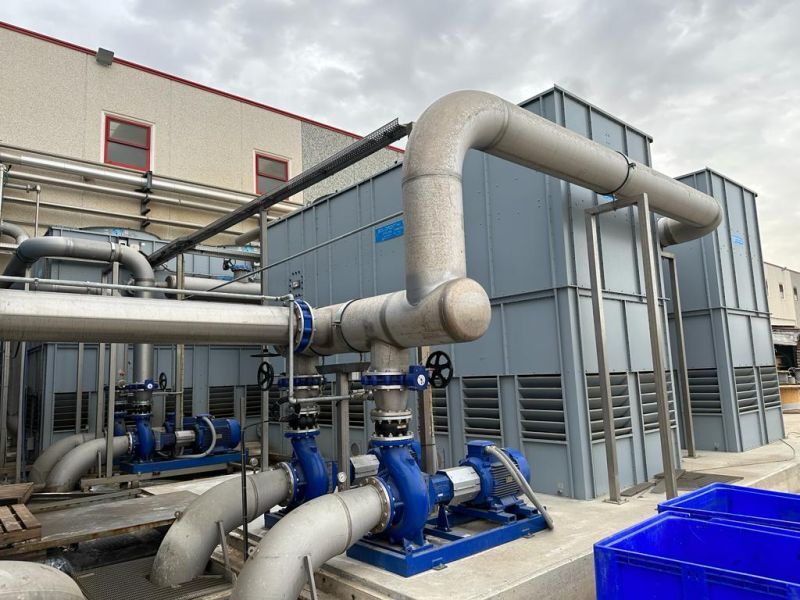Introduction
Evaporative cooling systems are increasingly used in large-scale food processing plants due to their ability to provide energy-efficient and environmentally friendly temperature control. These systems rely on the natural cooling effect of water evaporation to reduce air temperature, making them a cost-effective and sustainable alternative to traditional cooling methods. However, implementing evaporative cooling in food processing plants presents unique challenges that must be addressed to ensure efficient operations and compliance with hygiene standards.
Advantages of Evaporative Cooling in Food Processing Plants
Energy Efficiency:
- Consumes significantly less electricity than conventional refrigeration systems, reducing operational costs.
Eco-Friendliness:
- Eliminates the need for harmful refrigerants, supporting sustainability goals and reducing environmental impact.
Improved Air Quality:
- The system provides continuous fresh air, improving ventilation within the processing facility.
Cost-Effective Operations:
- Initial installation and operational costs are lower compared to complex refrigeration systems.
Humidity Control for Certain Products:
- Adds moisture to the air, which can be beneficial for preventing drying in specific food products.
Challenges in Implementing Evaporative Cooling
Maintaining Hygiene Standards:
- Food processing requires highly sanitized environments, and evaporative systems risk contamination from waterborne pathogens or airborne particulates.
Controlling Excess Humidity:
- While the added moisture can be beneficial, excessive humidity can lead to mold growth, food spoilage, or equipment corrosion.
Water Management Issues:
- High water consumption in evaporative systems may be unsustainable in regions with water scarcity.
Performance in Humid Climates:
- The cooling efficiency decreases significantly in areas with high ambient humidity, requiring additional cooling measures.
Maintenance and Scaling:
- Mineral deposits on cooling pads and internal components can reduce efficiency and increase maintenance needs.
Uneven Temperature Distribution:
- Large facilities with complex layouts may face challenges in maintaining consistent cooling across different zones.
Solutions to Address Challenges
Hygiene Management:
- Use advanced filtration and water treatment systems to eliminate microbial risks and ensure air quality.
- Regularly inspect and sanitize the system to meet hygiene standards.
Hybrid Cooling Systems:
- Combine evaporative cooling with refrigeration systems to manage humidity and achieve precise temperature control.
Water Conservation Measures:
- Incorporate water recirculation systems to minimize wastage and improve sustainability.
Automated Control Systems:
- Implement AI-driven systems for real-time monitoring of humidity, temperature, and airflow to optimize performance.
Advanced Materials and Design:
- Use corrosion-resistant materials and modular designs for durability and scalability.
- Employ improved cooling media that resist scaling and maintain efficiency over time.
Zone-Based Cooling:
- Divide the facility into cooling zones with independent controls for consistent temperature distribution.
Applications of Evaporative Cooling in Food Processing Plants
Meat and Poultry Processing:
- Maintains cold temperatures to prevent bacterial growth and extend product shelf life.
Dairy Production:
- Controls temperature for milk processing, cheese aging, and storage to ensure product quality.
Beverage Manufacturing:
- Maintains stable temperatures for bottling and fermentation processes.
Fruit and Vegetable Storage:
- Prevents spoilage by keeping produce fresh during storage and packaging.
Bakery Operations:
- Regulates heat levels during proofing, cooling, and storage of baked goods.
Future Trends in Evaporative Cooling
Integration with Renewable Energy:
- Solar-powered and wind-assisted cooling systems reduce reliance on traditional energy sources.
AI-Driven Optimization:
- Smart cooling systems equipped with AI can adjust airflow, water usage, and cooling intensity automatically for maximum efficiency.
Low-Water Consumption Designs:
- Development of advanced evaporative cooling media and closed-loop water systems to conserve resources.
Scalable Modular Systems:
- Modular designs allow facilities to expand cooling capacity as processing needs grow.
Sustainable Cooling Technologies:
- Innovations in materials and system design focus on reducing energy and water usage while maintaining performance.
Conclusion
Evaporative cooling systems represent a promising solution for large-scale food processing plants by offering energy efficiency, environmental sustainability, and cost-effectiveness. Despite challenges like hygiene management, water usage, and humidity control, these systems can be optimized through innovative technologies and careful system design. As the industry evolves, advancements in renewable energy integration, AI optimization, and sustainable materials will further enhance the viability of evaporative cooling, making it a critical component in the modernization of food processing facilities.

